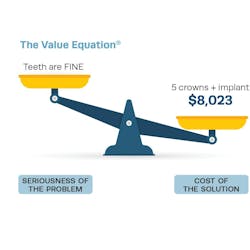How to sell dentistry without being “salesy”: The RAPPORT approach
I was enjoying a rare vacation from my practice when I was approached by somebody offering to make my next trip free. All I had to do was sit through a presentation about a local hotel that offered fractional ownership. In my holiday stupor, I thought this sounded like an amazing deal. I figured that I could take a little time out of my vacation to scout another hotel, get some free cocktails and—voilà!—my next trip was covered! Paradise, here I come!
After four and a half hours and more than one margarita, I was signing on the dotted line for a timeshare that I never visited in 10 years. What a deal. I was sold something that I did not want based on values that were clouded by drinks and an artificial experience.
Have you ever been sold something and then felt like you needed a shower afterwards? We have all had uncomfortable selling experiences in our lives. What if you could sell your patients needed dentistry in a way that builds rapport and trust? The reality is that nobody likes being sold to but, conversely, most people love buying. We live in a highly consumer-driven society, and our patients are no different when it comes to their dentistry.
As dentists, our primary competition is with consumerism and where patients’ dollars go, with a higher value placed on possessions than on oral health.1 According to Jeffrey Gitomer, author of The Sales Bible, “People buy things for emotional reasons, such as feeling significant, and justify those reasons with logic.”2 Our patients often do not buy dentistry based on logic because, if they did, they would do everything we recommend.
Patients may not even be aware of their oral health needs. Part of our job is to evaluate and diagnose what those needs are and provide a solution. Isn’t that what we do every time we tell somebody they have periodontal disease? Patients do not typically know that they have periodontal disease. It does not hurt and it is usually not the reason they have come to see us. We often hear patients say things like, “Why do I need a crown? My teeth feel fine,” or “Can’t you just do the cleaning that my insurance covers?” People buy on emotion and support their decisions with logic. If somebody is not enrolled in what we are offering as a solution, then we need to sell them on why our solution meets their needs.
If unscheduled treatment is an issue for you, there are ways to help your patients accept your treatment recommendations. For the last 25 years, I have been using a question-based technique that has delivered great results. This sales technique that I created specifically for health care is called “RAPPORT-based selling.” This technique allows you to build trust and share optimal treatment solutions with your patients. Of course, the foundation of this technique is rapport, but RAPPORT-based selling also stands for Relational, Assessment, Plight, Prognosis, and Treatment.
You must first prove value
Rapport is one of the most valuable relational tools you have when connecting to patients. When you review your schedule at the end of the day, you might complain that your patients did not schedule their treatment. The reason may be that you proposed a huge treatment plan without providing value and then delegated the cost of the solution to someone with minimal training. The patient may be confused and doubtful that they need thousands of dollars’ worth of work, and instead of scheduling their next appointment, they simply disappear. The bottom line is that you need to prove the value in your treatment plan before you present the cost of the treatment. This is what Neil Rackham refers to as the “value equation.”3
Without value, all the patient hears is cost
The cost of room at a Motel 6 ($64/night) and a Ritz-Carlton ($1,200/night) is significantly different, and the value for each is also different. As far as the patient is concerned, their teeth feel fine (Motel 6) but you just told them they need $8,000 worth of work (Ritz-Carlton). Helping the patient understand the value of your treatment is helping them understand the seriousness of the problem and the cost of not having treatment performed. Your job is to first prove value before you present the cost of treatment.
Imagine a scale where one side is the value and the other side is the cost of something. Your job as a provider is to add weight to the value side of the scale. There are multiple reasons for needing a crown on a tooth, but what most patients hear above all is the cost. Intraoral photos, models, and AI can add proof to what you are saying. When you show your patients proof, you are simply the messenger.4 Value is created by sharing your knowledge so the patient understands the seriousness of the issue at hand before you discuss the cost of the solution.
RAPPORT-based selling gives you a format for proving value first and allowing your patients to understand the options while engaging them in the process of buying dentistry instead of being sold dentistry. This process also gives you a greater understanding of your patients, their values, and their goals. It also builds relationships and trust and guides patients toward needed treatment.
The largest sales study ever conducted found that using a similar question-based technique produced an average 17% increase in sales.3 Let’s examine what RAPPORT-based selling looks like.
Relational questions: These are the important starting point because they build rapport with patients. Rapport is the process of building links with other people, which builds trust. I have found that you need about four links or similarities with people to move toward trust. Relational questions help establish these links, and while you may be busy, it is critical to take that time with people. Without rapport, you are simply a technician, and while you may be respected, an essential and foundational level of trust is bypassed. Studies have found that lack of trust by the patient decreases the likelihood of taking a provider’s advice. Build rapport with the patient, and then you can continue with your questions.
Assessment questions: Now that you have established a level of trust and rapport, you can evaluate the symptoms. Assessment questions often require a simple binary response: yes or no. These questions gather symptomatic information and often alert the patient to a problem they may not be aware of. An example would be, “Does this cracked tooth hurt you?” or “Do your gums bleed when you brush and floss?”
Plight questions: These questions ask about the patient’s predicament, difficulties, or dissatisfaction. For example, if you are focusing on a specific tooth, you might ask, “Does the pain keep you from enjoying your life?” or “Is there anything about your bite that you think can be improved?”
Plight questions get your patients to think about the issues in terms of the broader picture and how their oral health might affect their quality of life. These are very similar to assessment questions, but they take it a step further and may be more engaging or thought-provoking. Dentists often do not ask enough plight questions out of fear of being too intrusive when, in fact, patients prefer these questions over relational and assessment questions.5 Asking plight questions proves to your patients that you are concerned about their problems.6 However, once again, do not start asking plight questions until you have established rapport.
Prognosis questions: Prognosis questions ask about the issues and sequelae while planting seeds about the effects or repercussions. For example, “See how these lower teeth are misaligned? What effect do you think that has on the health of your gums?” With prognosis questions, you can codiagnose with your patient by showing them photos, videos, and other aids. Dentists often do not ask prognosis questions. You might feel like you are being pushy or preachy. An example of a prognosis question is, “What do you think might happen if you keep smoking another 15 years?” This type of question challenges our patients, and it can feel intimidating to challenge other people’s reasoning. We avoid these questions because we do not want to invade patients’ lives.5
But prognosis questions are the impetus that gets our patients to realize what we, as doctors, are thinking. Prognosis questions elevate us from technicians to teachers. They show that we care and are knowledgeable. These are the questions that get people to act. These are the questions that patients later say got them to stop certain behaviors or move forward with treatment. We need to move past our fear of asking, “What do you think the cost of doing nothing is going to be?” By asking more prognosis questions, we can help our patients avoid pain and more costly procedures and lead them to optimum oral health.
Treatment questions: Treatment questions ask about the value, significance, or usefulness of your proposed treatment. If these questions are presented properly, they will allow your patient to explain to you what the benefits would be and help you understand the level of urgency that they have.
Treatment questions should slant heavily toward extracting benefits of ethical treatment. The benefits directly correlate to the needs expressed by the patients from your prognosis questions. When asking treatment questions, you must base your benefits on the needs of the patient. In fact, research has proven that benefits are the best way to present treatment options to meet the needs of patients.7,8 You cannot just start talking about crowns, implants, and other complex treatment options if the patient has not expressed any needs. Remember, your questions are carefully chosen so that you can codiagnose the patients’ needs. Ideally, you want them to tell you what is wrong with their bite, teeth, gums, etc. Then, your treatment questions will help you present the benefits of treatment options based on their distinct needs.
Treatment questions have the patient explain the benefits of the treatment. An example of a treatment question is, “How would pulling that tooth before it flares up make you feel?” By linking your treatment options to the needs of the patient, you have shown them that you care and can help them with their problem.
By asking questions, we learn our patients’ needs while build rapport and trust. RAPPORT-based selling is simply an adjunct to your current system and produces improved results in how you deliver dentistry to your patients. You never want your patients to feel like they were sold a timeshare! Help them buy the treatment that meets their needs that you have codiagnosed. Build rapport, ask questions, and elevate your level of care.
Editor's note: The article appeared in the October 2024 print edition of Dental Economics magazine. Dentists in North America are eligible for a complimentary print subscription. Sign up here.
References
- LaVeist TA, Isaac LA, Williams KP. Mistrust of health care organizations is associated with underutilization of health services. Health Serv Res. 2009;44(6):2093-2105. doi:10.1111/j.1475-6773.2009.01017.x
- Gitomer J. The Sales Bible. Harper Business; 2008.
- Rackham N. SPIN Selling. McGraw-Hill; 1988.
- Alavi S, Habel J, Schwenke M, Schmitz C. Price negotiating for services: elucidating the ambivalent effects on customers’ negotiation aspirations. J Acad Mark Sci. 2020;48:165-185. doi:10.1007/s11747-019-00676-4
- Platt J, Taylor LA. Fifty years of trust research in health care: what does it mean for policymakers? Milbank Memorial Fund. January 24, 2023. Accessed March 26, 2023. https://www.milbank.org/2023/01/fifty-years-of-trust-research-in-health-care-what-does-it-mean-for-policymakers/
- Jopson B. Why are so many Americans crowdfunding their healthcare? Financial Times. January 10, 2018. https://www.ft.com/content/b99a81be-f591-11e7-88f7-5465a6ce1a00
- Keränen J, Salonen A, Terho H. Opportunities for value-based selling in an economic crisis: managerial insights from a firm boundary theory. Ind Mark Manage. 2020;88:389-395. doi:10.1016/j.indmarman.2020.05.029
- Feldman R. Advertising medicine: selling the cure. Stanford Tech Law Rev. 2023;26(1):1-4.
About the Author

Andrew Goldsmith, DDS, DICOI, FIALD
Cofounder, Smile Source
Andrew Goldsmith, DDS, DICOI, FIALD, graduated from the University of Nevada, Reno and Marquette University School of Dentistry. Dr. Goldsmith cofounded Smile Source, which now has more than 700 locations. He has published multiple journal articles and has spoken to dentists around the world. He currently practices in Houston, TX, and hosts the HowDent podcast, which discusses how things are made in dentistry. Dr. Goldsmith can be contacted at andygoldsmith.com.


